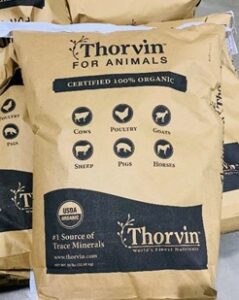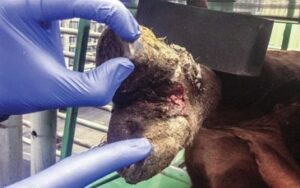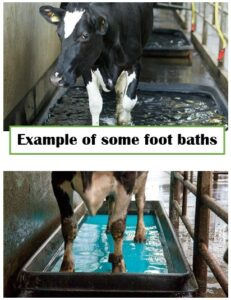It is estimated that approximately 20% of lameness in cattle – dairy and beef is attributed to foot rot. Foot rot is an infectious condition that causes swelling, heat, and inflammation in cattle’s feet, resulting in severe lameness. Bacteria are responsible for causing foot rot. Fusobacterium necrphorum is the main foot rot causing bacterium. All the foot rot-causing microbes are mainly anaerobic, meaning they thrive in an environment without oxygen. Many of these bacteria are found in feces, so even healthy feet are present with bacteria. It is not until there is an injury to the foot, caused by walking on rough surfaces or standing in wet, damp, and/or muddy conditions, which results in bacteria setting in and causing foot rot. Mineral deficiencies in zinc, selenium and copper are also known causes of foot rot. It will take about a week for the bacteria to set up an anerobic conditions. Once there is anaerobic conditions the bacteria will multiply rapidly and secrete toxins that cause tissue damage. Then the animal will go lame as it becomes inflamed and swells do to an immune response. Since foot rot is caused by an overload of bacterium in cattle’s environment, it is not considered contagious.
- Extreme pain, leading to the sudden onset of lameness
- Elevated body temperature
- Bilateral swelling of the interdigital tissues, around the hairline and coronary band of the swelling may lead to greater-than-normal separation of the claws
- Necrotic lesions in the interdigital space, with a foul odor
- Decreased feed intake
Ways to Prevent Foot Rot
- Environmental hygiene is a key component in preventing foot rot
- Keep lots free of hard objects such as stones, bricks, machinery, or anything that could bruise or cut the soft tissue of the foot.
- Minimize abrasive surfaces, especially around feeding and watering Cover rough surfaces with clay or cured, composted manure.
- Remove manure
- Put slabs along water tanks and feed
- Promote drainage by using mounds of soil or composted
- Maintain maximum drainage of lots and around water tanks, feed bunks, and other busy traffic areas.
- Keep lots free of hard objects such as stones, bricks, machinery, or anything that could bruise or cut the soft tissue of the foot.
- Good nutrition with adequate levels of Vitamin A, Vitamin D, selenium, copper and zinc.
- Prevent bruising during the harsh winter months by keeping lots clear of ice chunks and frozen manure
- Ensure that cattle receive adequate nutrients for good bone and tissue health
- Isolate sick animals
- Management should also include regular herd checks focused on early detection. If cattle are being managed and pulled in a timely fashion, most cases can be treated successfully.

The benefits of feeding kelp to the herd include improved reproduction health, improved calf development, and preventing disease. Kelp enhances cattle performance in many ways. It includes selenium and zinc, which supports breed back. It also supports animal health, for it contains zinc and iodine, which prevents foot rot and also contains copper and selenium that prevents pink eye. Kelp is a great source in filling in micronutrient deficiencies so the herd can improve the digestive, reproductive, and immune systems. Healthier cattle equal better productivity.
Thorvin is an all-natural organic kelp product for animals. It is the best of the best when it comes to kelp. They dry their products slowly with geothermal energy to hold in all the natural minerals and vitamins without cooking and burning them out. Throvin compared to other kelp has the highest selenium content whereas other kelp products can’t even put selenium on their label for the content is so small.



